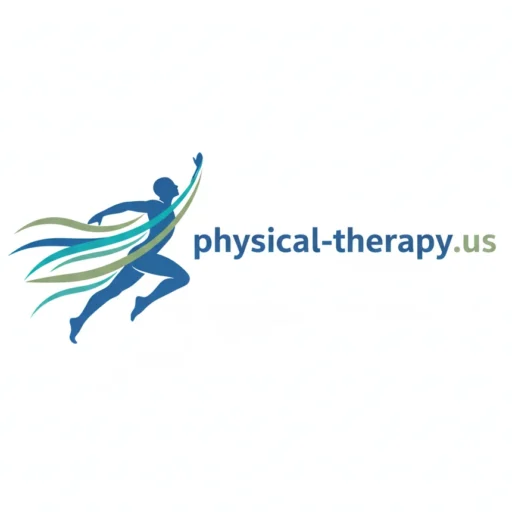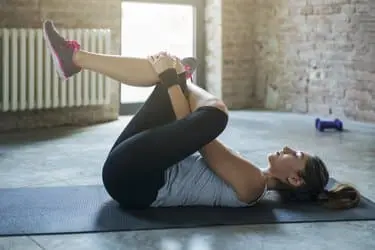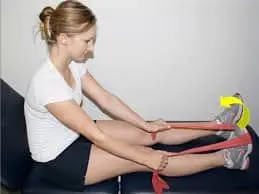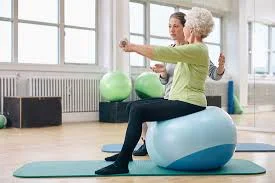Different Types of Breathing Exercises and Their Benefits
Breathing Exercises: What Is It?
The autonomic nervous system regulates breathing, which is also governed by motivation. Breathing exercises are one kind of exercise that may improve the overall efficiency of the lungs. They may be advantageous for people with normal lungs as well as those with impaired lung function.
Stress affects our breathing even when we are not ill, and if left unsolved, this can eventually result in irregular breathing patterns. (breathing pattern disorder) Breathing abnormalities may disrupt oxygen and carbon dioxide exchange, causing anxiety, panic attacks, fatigue, and other mental and physical health problems.
Breathing exercises are easy methods that help you manage your breathing. Our breathing typically quickens when we’re stressed or nervous, which might actually increase our anxiety levels. However, you can break the cycle in a way that naturally calms your body and mind by practicing concentrated breathing.
There are numerous ways, and each one has a specific region of intention or operates slightly differently. While some breathing techniques are excellent for lowering anxiety, others can help you focus better, relax your muscles, or even get ready for a restful night’s sleep.
In order to manage stress, improve their sleep, and maintain calm and concentration throughout the day, many people use breathing techniques during difficult times or just as part of their everyday routine.
Benefits of breathing techniques
You might be thinking whether something so basic can actually resolve every issue you face. The answer is no—they can’t finish that project or fill your shopping cart, but they can help you in many ways with your physical and mental well-being.
- Reduces stress and anxiety: Breathing exercises can help you feel more relaxed and in control by reducing the body’s stress response.
- Enhances concentration and focus: You may maintain your focus and involvement by taking a few deep breaths.
- Helps in emotion management: By concentrating on your breathing, you can feel more comfortable and in control, which can help you deal with emotions more effectively.
- Enhances physical health: Specific breathing techniques can enhance circulation, immunological response, and lung capacity.
- Promotes better sleep: You can fall asleep more quickly and have higher-quality sleep by practicing breathing techniques like the 4-7-8 breathing technique.
- Enhances mood and mental health: Some methods, such as resonance breathing, which involves taking calm, even breaths—typically five to six per minute—can elevate your mood and general sense of well-being.
- Gives you a sense of control: Breathing techniques serve as a reminder that you are capable of maintaining calmness even under difficult conditions.
Types of Breathing Exercises
There are several types of breathing exercises:
- Deep Belly Breathing
- Diaphragmatic Breathing
- Pursed-lip breathing
- Segmental Breathing
- Box Breathing
- The 4-7-8 Breathing Technique
- Alternate nostril breathing
- Lion’s Breath
- Resonant Breathing
- Humming bee breath
- Breath counting
- Paced breathing
- Sitali Breath
Deep Belly Breathing
This method is one of the easiest yet most powerful ways to relax your body and mind, and it’s particularly helpful when you need to reduce tension, feel more centered, or get ready for a good night’s sleep.
How to practice:
- Select a comfortable position to sit or lie down. As you inhale deeply through your nose, let your stomach rise as you fill your lungs, and place one palm on your tummy to help you feel each breath.
- Feel your tummy drop as you slowly release your air through your mouth after holding it for a few seconds. For five to ten breaths, repeat this pattern, allowing your body to relax with each exhale.
Diaphragmatic Breathing
You may make better use of your diaphragm by practicing diaphragmatic breathing, often known as belly breathing.
Additionally, it might lessen tension and assist with health condition-related difficulties like
- Problems of eating and constipation
- Headaches from migraines and elevated blood pressure
Spend five to ten minutes, three to four times a day, practicing diaphragmatic breathing.
You can feel exhausted when you first start, but the technique should get easier and feel more natural with time.
How to perform it:
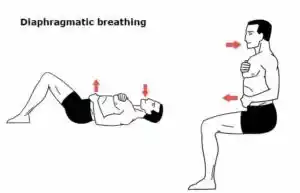
- With your head resting on a pillow and your knees bent slightly, lie on your back.
- For support, you can put a pillow below your knees.
- To feel the movement of your diaphragm, place one hand on your upper chest and one below your rib cage.
- As you inhale deeply and slowly through your nose, feel the pressure of your stomach against your hand.
- As much as you can, keep your other hand still.
- Keeping your upper hand perfectly constant, tighten your abdominal muscles and exhale with pursed lips.
To make the exercise more challenging, you can rest a book on your stomach. You can try belly breathing while sitting in a chair to make it more challenging after you’ve done it while lying down. After that, you can put the concept into practice while going about your regular activities.
Benefits of diaphragmatic breathing exercises
- Stress Reduction: The parasympathetic nerve system, which encourages relaxation and inhibits the fight-or-flight reaction, is activated by deep belly breathing.
- Reduced Heart Rate and Blood Pressure
- Deep breathing can assist in reducing heart rate and blood pressure by relaxing the nervous system.
- Better Lung Function: By using the diaphragm, the main breathing muscle, diaphragmatic breathing can increase oxygen intake and lung capacity.
- Improved Oxygenation: Deep breathing makes sure that more oxygen enters the blood, raising the body’s oxygen content overall.
- Decreased Muscle Tension: Deep breathing may relax tense muscles, especially those in the shoulders and chest, which are frequently tense during stressful situations.
- Better Absorption: Deep breathing can help maintain a healthy digestive system by encouraging calm.
- Enhanced Core Stability: The diaphragm and other core muscles are strengthened by diaphragmatic breathing, which contributes to increased stability.
- Increased Focus and Concentration: Deep breathing helps improve focus and concentration by calming the body and mind.
- Decreased Depression and Anxiety: By encouraging relaxation and lowering stress hormones, deep breathing can help control the symptoms of anxiety and depression.
- Increased Body Awareness: Deep breathing has the potential to heighten consciousness of the body and its relationship to the breath.
- Better Sleep: Consistent deep breathing exercises can encourage calmness and enhance the quality of your sleep.
Pursed-Lip Breathing
By requiring you to put careful thought into each breath, this easy breathing technique helps you slow down your breathing speed.
Any time is a good time to practice pursed-lip breathing. It might be particularly helpful when bending, lifting, or climbing stairs.
To properly master the breathing rhythm, start by practicing this breath four to five times a day.
How to do it:
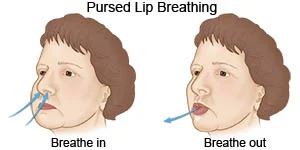
- Let your shoulders and neck relax.
- Take two calm breaths through your nose while keeping your mouth shut.
- As if you were about to whistle, contract or tighten your lips.
- Breathe out slowly for four counts while blowing air through your pursed lips.
Segmental Breathing Exercises
This exercise can be performed for different lobes:
- Lateral costal expansion
- Posterior basal expansion
- Right middle lobe expansion (lingual expansion)
- Apical expansion
Lateral costal expansion
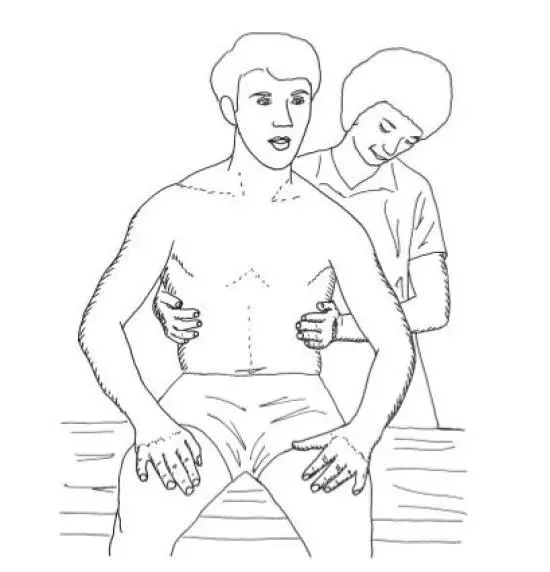
- Put your hand on the rib cage’s lateral side.
- The rib cage should be inside and downward when you ask the patient to exhale.
- The therapist should use their palms to press on the patient’s rib cage as they expire.
- Stretching downward and inward to the chest is necessary prior to inspiration in order to promote the external intercostal contraction.
- The chest will expand, and the patient will be greatly inspired if you apply normal force to the lower rib cage to stimulate it.
- The therapist will squeeze the rib cage inward and downward as the patient expires.
- The patient might do it manually by using a towel or his hand to exert force.
Posterior basal expansion
- Lean forward on a pillow while sitting, bending your hips slightly.
- Cover a posterior rib segment with the physiotherapist’s hand.
- Put your hand on the rib cage’s lateral side.
- The rib cage should be inside and downward when you ask the patient to exhale.
- The therapist should use their palms to press on the rib cage as the patient expires.
- Stretching downward and inward to the chest is necessary prior to inspiration in order to promote the external intercostal contraction.
- The chest will expand, and the patient will be greatly inspired if you apply normal force to the lower rib cage to stimulate it.
- The therapist will squeeze the rib cage inward and downward as the patient expires.
- The patient may ask to use a towel or his hand to apply force in an indirect manner.
Right Middle Lobe Expansion
- The patient is seated, and the therapist should place their hand below the axilla on either their right or left side.
- The rib cage should be inside and downward when you ask the patient to exhale.
- The therapist should use their palms to press on the rib cage as the patient expires.
- Stretching downward and inward to the chest is necessary prior to inspiration in order to promote the external intercostal contraction.
- The chest will expand, and the patient will be greatly inspired if you apply normal force to the lower rib cage to stimulate it.
- The therapist will squeeze the rib cage inward and downward as the patient expires.
- The patient might do it manually by using a towel or his hand to exert force.
Apical Expansion
- The therapist’s hand should be beneath the patient’s clavicle while they are seated on a chair or bed.
- Apply pressure with the palm or fingertip directly beneath the clavicle while the patient exhales.
Box Breathing
Also known as square breathing
Box breathing, a popular method for people who need to manage stress while on the go, is perfect for high-stress circumstances since it balances oxygen levels, lowers heart rate, and rapidly puts your body in a peaceful state.
How to do it:
- Picture a box with one side indicating each short breath. As you visualize moving up the side of the square, take a calm, four-count breath through your nose.
- Hold your breath for another four counts along the top of the square. Then, exhale for four counts as you walk down the box. Finally, pause for a final four-count to return to the starting place. Focus on keeping an even rhythm as you continue for a few rounds.
The 4-7-8 Breathing Technique
This method has the goal to reduce anxiety and relax the nervous system. When you’re feeling ready for sleep at the end of the day, it’s very helpful for calming down. If you want to improve your sleep, try these eight breathing techniques.
How to perform:
- Hold your breath for seven counts after inhaling through your nose for four counts. For eight counts, exhale slowly through your mouth, trying to exhale completely and gently. Let yourself completely relax as you repeat this process three or four times.
Benefits of the 4-7-8 breathing technique
- Reducing Stress and Anxiety: The 4-7-8 technique can help lower stress hormones like cortisol, relax the neurological system, and promote calmness.
- Better Sleep: This method can help people fall asleep more quickly and have better quality sleep by encouraging relaxation.
- Reduced Blood Pressure and Heart Rate: Deep, slow breathing can assist in controlling blood pressure and heart rate, improving cardiovascular health in general.
- Increased Mindfulness and Concentration: Paying attention to the breathing pattern and the counting sequence will help you become more mindful and concentrate better.
- Emotional Regulation: By encouraging a sense of composure and control, the 4-7-8 approach can assist in controlling emotional reactions, including anger.
- Enhanced Lung Performance: Exercises involving deep breathing can enhance lung function and capacity.
- Vagus Nerve Stimulation: The parasympathetic nervous system’s vagus nerve can be stimulated by the 4-7-8 breathing technique, which encourages calm and well-being.
Alternate Nostril Breathing
Breathing through alternate nostrils may help focus, reduce tension, and balance energy. It’s an excellent choice if you need a fast reset and are feeling exhausted, either physically or psychologically.
How to Practice:
- Put your left hand on your knee while sitting comfortably. Close your right nostril softly with your thumb, then take a deep breath through your left.
- Use your ring finger to close your left nostril, open your right, and then exhale completely with your right nose. Close your right nostril after taking a breath, then release it with your left. Five to ten times, repeat this alternate pattern.
Benefits of alternate nostril breathing
- Help to reduce stress
- Help to reduce anxiety
- Help people to relax.
- Lower blood pressure
- Lower heart rate
- Help with breathing
- Enhance brain activity, which includes helping with movement and memory.
Lion’s Breath
A stimulating yoga breathing technique called lion’s breath may assist in reducing facial and jaw muscular strain.
In yoga, it’s also referred to as Simhasana, or Lion’s Pose in Sanskrit.
How to perform this:
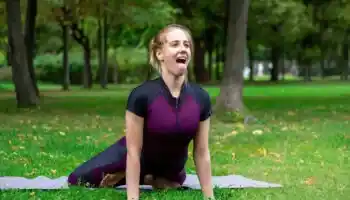
- Sit down in a comfortable position. You can cross your legs or sit back on your heels.
- Spread your fingers wide and press your hands against your knees.
- Open your eyes wide and take a deep breath through your nose.
- Simultaneously, extend your mouth wide and bring the tip of your tongue down toward your chin.
- Make a lengthy haaa sound as you exhale through your mouth, contracting the muscles at the front of your throat.
- You can shift your attention to the tip of your nose or the area between your eyebrows.
- Repeat this breath two or three times.
Resonant Breathing
Five complete breaths per minute is referred to as resonant breathing, or coherent breathing. By inhaling and exhaling for five counts, you can reach this rate.
This pace of breathing increases heart rate variability (HRV), lowers stress, and, when paired with Iyengar yoga, can lessen depressive symptoms.
How to accomplish this:
- Take a five-count breath.
- Take a five-count breath out.
- For a few minutes or more, keep breathing in this manner.
Humming Bee Breath
The unique feeling of this yoga breathing technique helps to bring about immediate relaxation and is particularly calming around your forehead.
Humming bee breath is used by some to reduce anger, anxiety, and frustration. It may help you feel less worried or anxious, think more clearly, and lower your heart rate.
The ideal setting for practicing is one where you can hum freely.
How to accomplish this:
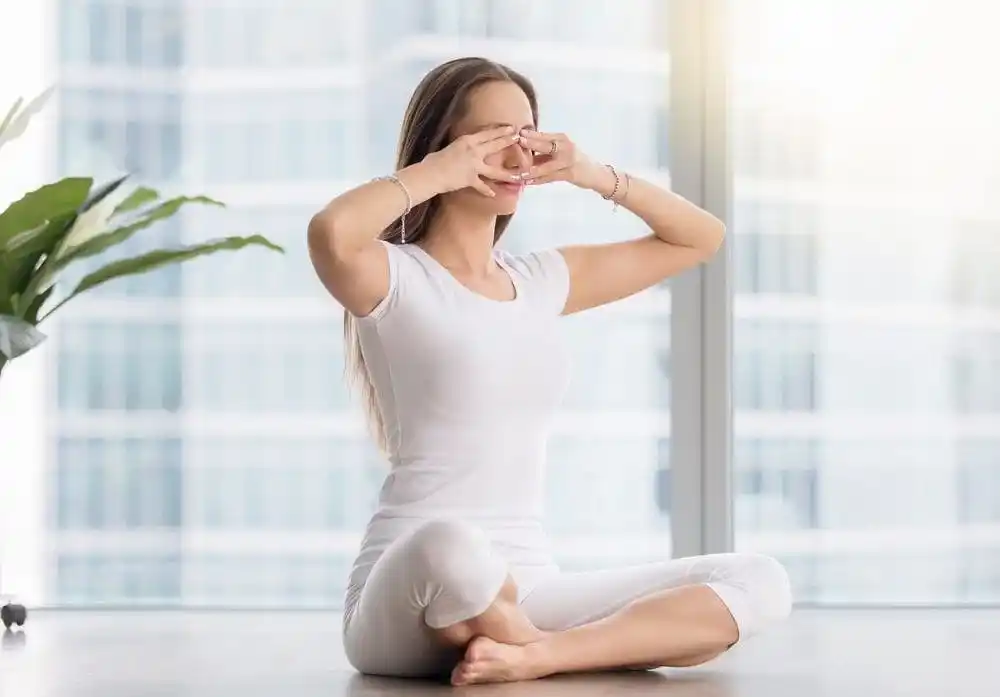
- Select a sitting position that is comfortable.
- Relax your face and close your eyes.
- Your ear canal is partially covered by tragus cartilage, which you should place your first fingers on.
- Gradually press your fingertips into the cartilage.
- Make a loud humming noise while keeping your mouth shut.
- Keep going for however long it feels comfortable.
Sitali Breath
You may relax your mind and reduce your body temperature by doing this yoga breathing technique.
Don’t force it; just slightly lengthen your breath. Sitali breath is inhaled through the mouth; therefore, you might want to practice in an area free of air pollution and other allergens.
How to do it:
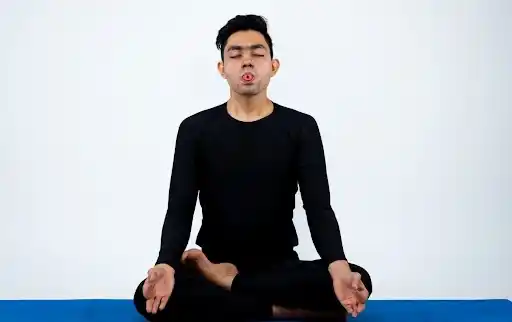
- Select a sitting position that is comfortable.
- Put your tongue out and shift it to bring the outer edges together.
- You can purse your lips if your tongue doesn’t do this.
- Breathe in with your mouth.
- Breathe out using your nose.
- For up to five minutes, keep inhaling in this manner.
Breath Counting
Counting your breaths can help you relax and calm racing thoughts, making it a mindful method that helps you focus on the here and now. This reduces tension and enhances concentration.
How to Practice:
- As you inhale, mentally count to one, and then release the breath normally. After that, count to two as you inhale, and then exhale silently. Continue until you reach ten, and then begin a new one at one. For five to ten minutes, try this, paying attention to your breathing rhythm. Restart at one if you lose count.
Paced Breathing
Using the paced breathing technique, you pay attention to how quickly and frequently you breathe. Hyperventilation is the term for conditions like stress and anxiety that make you breathe more rapidly. Some of the physical signs of stress and anxiety can be lessened by regulating your breathing rate and doing it carefully.
This variation of pursed-lip breathing is a little more complex. To ensure that the exhale is equal to or longer than the inhale, you are regulating the amount of time you spend breathing and exhaling.
There are numerous counts for breathing that is paced. While 4-7-8 breathing counts to four, then seven, and finally eight, square breathing consists of four counts of four.
To perform timed breathing with two distinct counts, follow these steps:
- First, exhale until your lungs feel empty, but not so much that it hurts.
- Step 2: Take a four-count breath. Try to fill your lungs to a full, comfortable capacity, and count as fast or as slowly as you prefer.
- Step 3: Hold your breath for four counts if you’re doing square breathing. Hold for a count of seven to practice 4-7-8 breathing. Make sure your counting pace matches the one you used during the inhale.
- Step four is to exhale for a count of eight for 4-7-8 breathing or four for square breathing. Over that count, completely empty your lungs.
- The fifth (optional) step: For a count of four, let your lungs empty if you’re doing square breathing.
Continue doing this until you feel more at ease, or as many times as you choose. Finding the counting speed that suits you may take some time, but that’s okay.
Benefits of Paced Breathing
- Falling asleep faster
- Managing stress
- Decrease headaches or migraines
- Decreased hypertension
- Reduced symptoms of anxiety
- Improved cognitive abilities
FAQs
Which breathing technique is best?
Abdominal breathing, also known as belly breathing, stimulates the neurological system and increases the amount of oxygen reaching your brain, which results in a calmer state. Stress and anxiety can be significantly reduced by engaging in focused breathing exercises for 20 to 30 minutes per day.
How can I get better breath?
Focus on maintaining proper oral hygiene (twice daily brushing, flossing, and tongue cleaning), scheduling routine dental exams, practising breathing techniques, and making changes to your lifestyle like stopping smoking and drinking plenty of water to help you breathe easier.
What is the best breathing treatment?
For COPD, nebulizers and inhalers are both useful respiratory devices. Inhalers are less efficient at treating respiratory conditions, though, because they are frequently used improperly. Find a breathing treatment that meets your medical requirements and way of life by consulting with your physician.
Neuro breathing: what is it?
The abnormal breathing pattern known as central neurogenic hyperventilation (CNH) is typified by deep, fast breathing that occurs at a rate of at least 25 breaths per minute. This respiration rate’s increasing irregularity is typically an indication that the patient is about to go into a coma.
What is breathing more quickly than usual?
If your breathing is too rapid, your doctor may refer to it as tachypnea, particularly if you have rapid, shallow breathing due to a lung condition or another medical condition. When you are taking deep, fast breaths, you are said to be hyperventilating.
At home, how can I check my breath?
Try it out with a short smell. If you want to quickly test yourself for bad breath, this procedure is undoubtedly effective. This bad breath test can be completed in a number of ways. You may determine whether your breath is foul by cleaning your wrist, letting it dry for a while, and then sniffing it.
References
- Calm Editorial Team. (2024, December 13). 10 types of breathing exercises (and how to practice them) — Calm Blog. Calm Blog. https://www.calm.com/blog/types-of-breathing-exercises
- Cronkleton, E. (2024, May 17). 10 breathing exercises to try when you’re feeling stressed. Healthline. https://www.healthline.com/health/breathing-exercise
- WebMD Editorial Contributor. (2023, July 2). Types of breathing exercises. WebMD. https://www.webmd.com/balance/types-of-breathing-exercises
